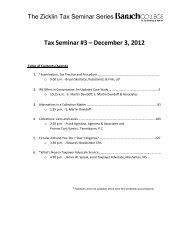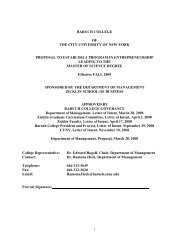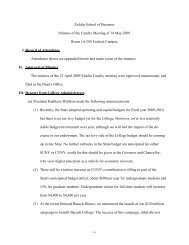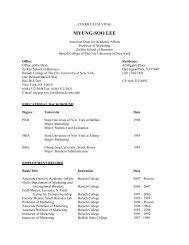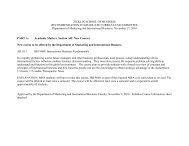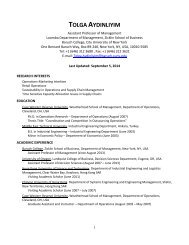Current Financial Reporting Trends
Current Financial Reporting Trends: - Zicklin School of Business
Current Financial Reporting Trends: - Zicklin School of Business
- No tags were found...
Create successful ePaper yourself
Turn your PDF publications into a flip-book with our unique Google optimized e-Paper software.
Please tell us how you have applied the guidance in paragraphs 12 - 32 of EITF 00-19 in<br />
evaluating whether the conversion features of the convertible notes payable are embedded<br />
derivatives that you should separate from the debt host and account for at fair value under SFAS<br />
133. While conventional convertible debt typically qualifies for the scope exception in paragraph<br />
11(a) of SFAS 133, your debentures are convertible into a variable number of shares (at the rate of<br />
the lesser of a specific per share amount or 70% of an average trading price of your common<br />
stock). Thus, the debt is not conventionally convertible and does not appear to qualify for the scope<br />
exception from the provisions of SFAS 133. As such, it appears the debt conversion feature should<br />
be bifurcated from the host contract (the debt) and accounted for as a derivative at fair value, with<br />
changes in fair value recorded in earnings. Please also tell us how you plan to account for the<br />
newly issued convertible debentures and warrants disclosed in your Form 8-K filed on February 24,<br />
2006 since these appear to contain similar conversion features and registration rights.<br />
After an initial response letter and follow up comment letter, the original comment was<br />
resolved in the following second and final response letter:<br />
Second Response to Comment #348 – Form 10-KSB; SIC: 8741 Services-Management<br />
Services<br />
1. Assessing the newly issued and exchanged convertible debentures and warrants and how we<br />
will record the issuance of the new notes and new changed notes.<br />
As the above comment points out, in accordance with Statement of <strong>Financial</strong> Accounting<br />
Standards No. 133, "Accounting for Derivative Instruments and Hedging Activities," as amended<br />
("SFAS 133"), and EITF 00-19, the holder's conversion right provision, interest rate adjustment<br />
provision, liquidated damages clause, cash premium option, and the redemption option (collectively,<br />
the debt features) contained in the terms governing the Notes are not clearly and closely related to<br />
the characteristics of the Notes. Accordingly, the features qualified as embedded derivative<br />
instruments at issuance and, because they do not qualify for any scope exception within SFAS 133,<br />
they were required by SFAS 133 to be accounted for separately from the debt instrument and<br />
recorded as derivative financial instruments.<br />
Notes Issued and Debt Features<br />
Pursuant to the terms of the Notes, these notes are convertible at the option of the holder, at<br />
anytime on or prior to maturity. There is an additional interest rate adjustment feature, a liquidated<br />
damages clause, a cash premium option, as well as the redemption option. The debt features<br />
represents an embedded derivative that is required to be accounted for apart from the underlying<br />
Notes. At issuance of the Notes, the debt features had an estimated initial fair value which will be<br />
recorded as a discount to the Notes and a derivative liability on the consolidated balance sheet.<br />
In subsequent periods, if the price of the security changes, the embedded derivative financial<br />
instrument related to the debt features will be adjusted to the fair value with the corresponding<br />
charge or credit to other expense or income.<br />
The estimated fair value of the debt features will be determined using the probability weighted<br />
averaged expected cash flows / Lattice Model. The model uses several assumptions including:<br />
historical stock price volatility (utilizing a rolling 120 day period), risk-free interest rate (3.50%),<br />
remaining maturity, and the closing price of the Company's common stock to determine estimated<br />
fair value of the derivative asset. In valuing the debt features at March 31, 2006, the company will<br />
use the closing price at March 31, 2006 and the respective conversion and exercise prices for the<br />
warrants.<br />
The proceeds from the financing transaction will be allocated to the debt features and to the<br />
warrants based upon their fair values. After the latter allocations, the remaining value, if any, is<br />
allocated to the Note on the financial statements.<br />
The debt discount will be accreted using the effective interest method over the term of the note.<br />
14



